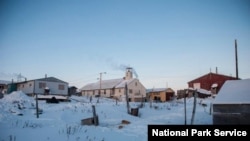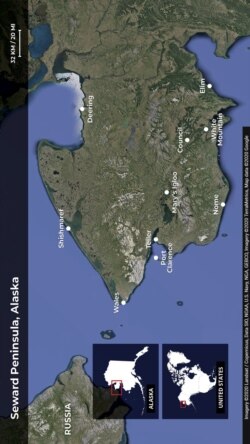Today, the small Native Inupiaq community of Shishmaref is best known for its struggle against coastal erosion: Set on a tiny barrier island in Alaska, just south of the Arctic Circle, it is slowly being eaten up by the rising Chukchi Sea.
But Shishmaref is also known as the only village in Alaska’s Behring Strait region to have thwarted the 1918 Spanish flu, which arrived in the port city of Nome in late October that year and quickly spread up the coast and within weeks, killed hundreds and left dozens of orphans.
The men of Shishmaref, forewarned, set up an armed barricade several miles down the coast between their town and the community of Wales, which they guarded around the clock to ensure, at gunpoint, that no one entered or left the village.
George Kitmusuk Olanna was among the sentries, according to his great granddaughter, Sherri Anderson, who grew up in Shishmaref but now lives 200 kilometers away, in Nome.
“He said that when he was standing ground, it was really stressful,” Anderson said. “It was hard to turn away people or tell others they couldn’t leave Shishmaref to visit their families in other communities.”
But responsibility to family and community are core Inupiat values, instilled in children from a young age, she said.
“Everybody in the community understood how bad the epidemic was,” she said, “and did what they had to do.”
Today, more than a century later, Shishmaref is looking to history to protect its citizens from the coronavirus. Like dozens of other rural villages, it has sealed itself off from the rest of the state: No one may enter the village except medical workers, emergency workers and essential maintenance workers; anyone who has traveled must self-quarantine for two weeks. There are no roads into Shishmaref; the only way to get there is by plane, snow machine or, in warm weather, by boat.
Anderson worries about whether the village can adequately fight COVID-19.
“Most of the community is still living without running water or a sewer system,” she said. “It’s unhealthy, but we’ve been doing it for the last hundred years or so.”
Village citizens haul water from the community “washeteria,” where they can also do their laundry and take showers.
“Our drinking water is melted ice,” she said. “In the summertime, it’s fresh rainwater.”
Toilets consist of so-called “honey buckets,” five-gallon buckets lined with plastic trash bags. Those who can afford it pay $40 a month to have them hauled away. Those who cannot leave the buckets to sit, and, says Anderson, as the weather warms, their contents tend to thaw and spill out into walkways, posing further health hazards.
There are no doctors in Shishmaref, which, like many other rural villages, relies on trained community health aides.
The closest hospital, a 45-minute air ambulance ride away in Nome, serves 15 villages across 114,000 square kilometers.
“We have been preparing for weeks,” said Reba Lean, public relations manager at Norton Sound Regional Health Corporation (NSRH), a tribally owned and operated nonprofit serving the health care needs of the Inupiat, Siberian Yup’ik and Yu’pik people of the Bering Strait region. “We’ve also been working hard to help our community feel prepared as well.”
NSRH holds daily teleconferences with village leaders and health workers, providing updates on the spread of the virus and information on how to identify and manage COVID-19 patients -- even how to use and safely dispose of honey buckets.
“We’ve held these calls every day except Good Friday,” Lena said. NSRH posts minutes of each call online for those who may have missed them.
If any villagers should get sick enough to require hospitalization, NSRH will arrange for an air ambulance to fly the patient to the Norton South Regional Hospital.
“We typically have 18 beds in our hospital,” said Lean, “but during this time we have the capacity to add more, and if there is a big outbreak in one of our communities, that is when we would set up a field hospital and send out medical providers.”
As of Friday morning, Alaska reported 300 cases of coronavirus, 35 hospitalizations, 110 recoveries and nine deaths.
So far, no one in Shishmaref has tested positive, but Tuesday, the Bering Strait region saw its first case, an employee at a Nome satellite and telecommunications company who is reported to be sheltering in place and keeping in touch with health authorities. It is not known whether the case was travel-related or spread from within the Nome community.
Anderson said the news has put everyone’s nerves on edge.
“I think this case was brought in during the end of the Iditarod sled dog race,” Anderson said, referring to the annual long-distance dogsled race from Anchorage to Nome, which took place last month. “Because it takes a couple weeks to get test results, who knows how long the person was showing signs or symptoms.”
Anderson, confined at home in Nome, spends her time stitching masks and praying that friends and family back in Shishmaref will show the same resilience they have always shown and escape this century’s pandemic as they did the last.










